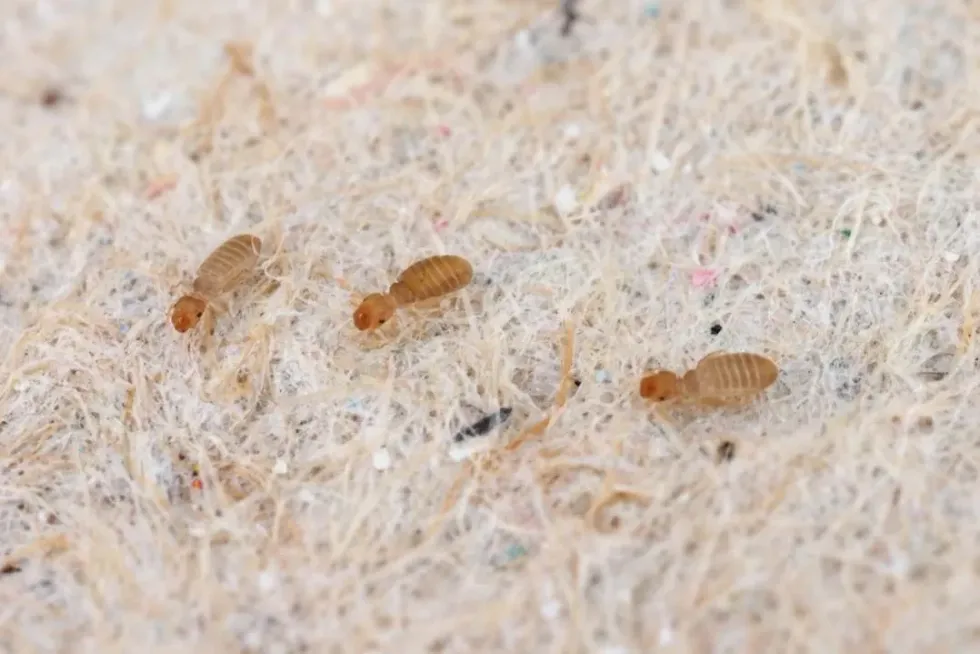Booklice or psocids are common household pests of the order Psocoptera. Pscopetera majorly feeds on organic detritus, fungi, lichen, and algae.
Barklice, which are quite similar to booklice, are subsumed under this order. The major difference between these two insects is that barklice are scavengers that tend to live outdoors in moist terrestrial areas. Whereas booklice are often found indoors, in places like houses or garages; optimal conditions being high humidity and moisture.
Despite the alarming name, you would be glad to know that these pests do not pose any threat to humans. They neither bite nor can live on humans.
Unlike true lice, psocids feed on the mold that grows in damp areas- walls, old documents, stored food or their namesake, glue on the book bindings. Booklice can enter any household supporting these conditions and it is not contingent on the house's hygiene status. Despite the small size of the booklice, the infestation would be visible and easily recognizable.
Psocids infestation is not a threat to your health, but you may want to get rid of them. Booklice treatment is rather easy. The goal should be to properly ventilate and dry out the area.
It is advised to also throw away the infected articles and wipe down the mold. Most of the time, using a dehumidifier helps. In case of a substantial infestation, you may contact pest control who get rid of these insects using professional methods.
If you found this informative article on psocids interesting do check out our other articles on the paper wasp and the burying beetle.
Booklice Interesting Facts
What type of animal are booklice?
A booklouse is a soft-bodied insect, of the order Psocoptera.
What class of animal do booklice belong to?
Booklice are arthropods belonging to the class of Insecta, categorized as insects.
How many booklice are there in the world?
Booklice are found in large numbers across the globe. While their exact population or origin is unknown, it is believed that have lived since the Permian period, some 250 million years ago. The claim is based on morphological studies showing minimal modifications compared to fossils.
Where do booklice live?
Booklice are often found indoors- in commercial places and human homes. In these regions, they mostly infest stored grains and mold on books or wallpapers. The most vulnerable areas thus being attics, basements, and closets.
What is a booklouse's habitat?
Booklice thrive in damp areas with high humidity and temperature. These conditions foster the growth of mold, which primarily attracts these pests. They can't survive in low humidity.
Similarly, barklice are found in moist areas. They frequent places such as leaf litter, tree barks, and sometimes bird nests. Being detritivorous by nature, they never feed on living beings, rather go after the organic debris.
Who do booklice live with?
Booklice are often found in large numbers. Average female booklice usually lay eggs in small clusters.
How long do booklice live?
An average booklice life cycle is not more than a few months. They may live for 24- to 110 days, which varies with the seasons. Higher humidity increases their longevity.
How do they reproduce?
Some of the female booklice can produce offspring without the process of fertilization. They lay eggs in small clusters or singularly. They hatch in approximately 21-24 days. Optimal temperature and humidity play an important role in its life cycle.
In winters, this incubation period is longer, up to three months. Females usually deposit their eggs in moist and dark places where they stick to the surface. Because of this characteristic, booklice eggs are often covered in dirt such as food, dust, or other such debris.
An adult female booklouse can lay up to 200 eggs in its lifespan. The ideal conditions for reproduction are not present throughout the year.
The booklice nymph usually undergo three to four stages or instars to mature as adults. This may take up to 10 days. The nymphs resemble the adults quite a lot but are found to be smaller in size.
These eggs are visible when they occur in clusters, but may not be when found in edible items. Booklice control thus sometimes requires us to throw away the infected material, especially when they occur in larger numbers
What is their conservation status?
IUCN Red List does not have an entry on this insect. However, it does categorize its close relative barklice as Least Concern and defines its population as stable.
Booklice Fun Facts
What do booklice look like?

Booklice are pale-translucent small creatures with sizes ranging from 1/16 inch to 1/25 inch. They have long and threadlike antennae, with 12-50 segments and a producing head with mouthparts for chewing food. These antennas tend to be as long as the body.
The body is connected to the head via a slender neck. These species are mostly wingless, whereas the adult barklice tend to have wings. Eyes are poorly developed resulting in poor vision.
How cute are they?
Psocids are translucent, microscopic, wingless pests that often crawl on books and stored food. This description cannot be termed as cute.
How do they communicate?
It is found that booklouse often have low visibility or poor vision and therefore they rely on sounds for communication. Often males of this species drum their abdomens with their antenna to produce a ticking sound. This sometimes is also classified as their mating call.
How big are booklice?
Booklice are really small insects, almost microscopic in nature. Its length varies between 0.04–0.4 in (1–10 mm). If one was compared to a garden ant, we can say that booklice are 25 times smaller than these ants.
How fast can booklice run?
Booklice run quite fast and are masters at hiding in the crevices of houses. However, they can't jump or fly.
How much do booklice weigh?
Booklice have negligible weight. An estimate shows their dry weight is around 27 mcg. It is to be noted that 1 mcg is equal to 0.000001 g.
What are their male and female names of the species?
The booklouse species has not been assigned separate names for its male and female members.
What would you call baby booklice?
A baby booklouse is called a nymph or larvae as most the baby insects. A nymph has to go through several stages to reach adulthood.
What do they eat?
Booklice as a species tend to feed on debris such as fungi, algae, and lichen. Indoor booklice species however mainly feed on mold. This can be found in places with high temperatures and humidity. Thus booklice bugs usually occur in places such as wallpaper, old books, and food items.
Are they dangerous?
No, contrary to what the name suggests, booklice do not cause any major harm to humans. In fact, most of the time booklice damage is minimal. It is directed towards book bindings and other documents since they feed on debris.
However, prevention is always better than cure. In this case, prevention follows similar patterns as pest control. Keep susceptible areas well-ventilated and low on humidity, and keep a check on any signs of mold.
It might be wise to keep in mind that in some cases they tend to exacerbate asthmatic tendencies, because of the mold.
Would they make a good pet?
While there is not much economic loss because of booklice infestation, these pests would not make good pets. It is advisable to employ pest control measures if found in your vicinity.
Did you know...
It is believed that the true lice (parasitic insects of birds and mammals) may have evolved from the order Psocoptera (comprising of both barklice and booklice).
Booklice may be the most primitive species of hemipteroids.
The central difference between booklice vs. bed bugs is the formation of their mouthparts. While bedbugs have a straw-like mouth, booklice have a paired mouthpart used for chewing.
It is shown that these pests are not very well adapted to their environment and cannot survive any extreme conditions- specifically high humidity
Why is the name booklice misleading?
Booklice is a misleading name because unlike lice, these insects are not parasitic in nature. In fact, they do not share any physical resemblance with the louse. Nor do they harm or bite humans.
Why are booklice often found in books?
Booklice are found in book bindings because they eat the starch used for the binding process. At times, really old books house mold, which is another attractive factor for the booklice.
Here at Kidadl, we have carefully created lots of interesting family-friendly animal facts for everyone to discover! Learn more about some other arthropods including Africanized bees and darkling beetles.
You can even occupy yourself at home by drawing one of our Booklice coloring pages.










